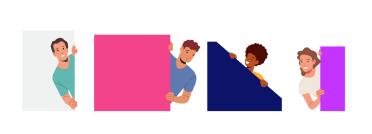As we begin to value the importance of user-centered design, we must look for ways to both strengthen empathy and get closer to our customers.
Speaking to customers about their experiences of using our services is a great way to gain insight into our services. Creating user personas which represent these customers is an excellent way to maintain this relationship and inform decisions.
Formats of personas vary, but generally resemble a “fictional” user profile of someone who would use your service, with an image, name, age, gender and some personal information specific to the project.
The personas content is based on what we already know about our customer's goals and behaviours. Ideally, we would also add insights we have gained from interviews and analysis of customer feedback.
What are Proto-Personas?
Proto-personas can be used when there isn’t enough time or budget to fully research a persona. They can be based on what we know or think we know about the users, their goals and their beliefs. Although not as ideal as using personas that have been validated with research, proto-personas can still help us make better design decisions and keep us focused on the customer.
Over time, as you learn more about you users, you can add to, amend or even discard the original proto-personas.
How personas help us make better decisions
In any design process, teams often have different opinions about who will be using the service and how which can result in us:
- Designing features for ourselves
- Shaping the perceived user to fit our design decision
- Disagreeing about key features and priorities
- Developing features that never get used (edge cases)
Personas give us an understanding & empathy for our customers experience, which we can use to inform these decisions.

Creating a Proto-persona
Participants in this exercise can vary, though it is always best to get participation from our client-facing teammates.
Brainstorm
We first need to gather information about our customers, their goals, needs and motivations. This can be done either as a group exercise or by questionnaire.
Visualise
This is best done as a group exercise, where we share the information we have gathered with our team.
Discuss
First, discuss and split the assumptions and data you’ve collected onto individual Post-it’s or small pieces of paper.
Name
Collectively think of a name for your fictional customer and choose a photo to represent them. This will bring your persona to life in a way your team can easily relate to.
Build
Divide a large piece of paper or a whiteboard into four boxes, with these titles:
| Photo & Name |
Behaviours
|
| Facts |
Needs & goals
|
Add the information you have gathered into the appropriate boxes, putting anything irrelevant to one side.
Create your Proto-persona visual
Take the draft persona you have created with your team and arrange your insights into an easily-understood visual, which communicates who your customer is and what problem you’re helping them solve.
Janice
|
Behaviours
|
Facts
|
Needs & goals
|
Repeat
Create at least three personas that match your typical services users, and add more if you feel you need more.
Practical applications
Multiple persona types
Studies have consistently shown us that if we design for everyone, we please no one. However, it is not uncommon to have multiple types of customers with different motivations and backgrounds . Therefore we need to focus on the persona who is the most important to the success of our business.
In this scenario, we will need to divide our profiles into primary, secondary and tertiary personas, and focus on creating the best experience for our primary personas, whilst simply satisfying the others.
Have a seat for the customer at every meeting
Share your persona(s) with your team and reference them every time you make a decision about your product, ensuring your persona’s needs are clearly met and their experience of your service is pleasurable.
Given the opportunity, test users who fit your personas and update your assumptions to make sure your observations are consistent and your assumptions check out.
Using your personas to answer questions
When we want to introduce or amend a feature we can now create user stories to help us visualise the experience from our persona's point of view.
For example, imagine we’re creating a video tutorial section for our website. Firstly we should ask if this is something our persona would engage with, and if so, write something to describe our persona’s motivations and how they might engage with the feature:
“Sarah is new to using websites to get information and advice about parenting. Her childcare responsibilities mean she has limited time, so needs to be able to find information fast and be able to conveniently return to it at a later date on whatever device she has to hand.”
Creating user stories like this both humanise the purpose of our services and help teams perceive user journeys.


